by Ven Venkatachalam, Lennie Kaplan and Mark Milke
Follow CEC on Linkedin CEC Linkedin
Follow CEC on Facebook CEC Facebook
Follow CEC on Twitter CEC Twitter

Workers assemble high-pressure pipe at hydraulic fracturing operation near Bowden, Alta. The Canadian Press
Canada’s natural resource sector is providing a pathway to economic opportunity for thousands of Canadian newcomers, says a new analysis by the Canadian Energy Centre.
According to the most recent data available from Statistics Canada, the number of landed immigrants employed in the resource sector (quarrying, mining and oil and gas extraction) grew from 22,000 in 2006 to a high of 33,600 in 2014, and in 2019 stood at 28,800.
Immigrants to Canada have benefitted from participation in the resource sector, as average weekly earnings for landed immigrants working in the resource sector are higher than for other goods-producing industries, and higher than the average of all other industries.
In 2019, immigrants to Canada employed in the resource sector earned an average weekly wage of $2,032. This was nine per cent more than those employed in utilities ($1,855), 31 per cent more than those in construction ($1,407), nearly twice as much those employed in agriculture ($1,041), and 71 per cent more than the average weekly wage for all industries ($1,186).
Between 2006 and 2019, average weekly wages for landed immigrants employed in mining, quarrying and oil and natural gas extraction sector grew from $1,395 to $2,032, an increase of nearly 46 per cent. This compares to an 18 per cent increase for agriculture, forestry, fishing and hunting; a 21 per cent increase for utilities; a 22 per cent increase for manufacturing, and a 42 per cent increase for construction. The all-industry average weekly wage increased by 28 per cent in 2019 relative to 2006.
———————————————————————————
Immigrants and employment in oil, gas and mining
In this Fact Sheet (which can be downloaded here as a pdf), we examine landed immigrant employment trends and incomes in the Canadian quarrying, mining and oil and gas extraction sector between 2006 and 2019.
The number of landed immigrants employed in the resource sector ranged from a low of 22,000 in 2006 to a high of 33,600 in 2014, and in 2019 stood at 28,800. Critically, immigrants to Canada employed in the resource sector earned nine per cent more than those employed in utilities, 31 per cent more than those in construction and nearly twice as much those employed in agriculture. Also, increases in immigrant wages between 2006 and 2019 were highest in the resource sector when compared with other major industries.
Background: Three types of immigrants
For the purposes of tracking economic progress, Statistics Canada divides landed immigrants into three groups:¹
- Very Recent Immigrants, also referred to as ‘newcomers’: Landed immigrants who have been in Canada for 5 years or less;
- Recent Immigrants: Landed immigrants who have been in Canada for more than 5 to 10 years; and
- Established Immigrants: Landed immigrants who have been in Canada for more than 10 years
1. This Brief uses data from the Labour Force Survey (LFS), a monthly household survey. The LFS data series on immigrants began in January 2006, when five questions were added to the questionnaire in order to identify immigrants and provide timely information on their labour market situation. The findings in this report are based on annual averages of estimates for the years 2006 to 2019. Three groups of immigrants are identified based on how long they have been in Canada as landed immigrants prior to being interviewed for the LFS.
Figure 1: immigrant employment and income trends in the resource sector 2006-2019
The Statistics Canada data show that landed immigrant participation in the Canadian mining, quarrying and oil and natural gas extraction sector has for the most part increased since 2006. In 2019, 28,800 landed immigrants were employed in the sector; lower than the high of 33,600 in 2014 but 31 per cent higher than the 22,000 immigrants employed in the sector in 2006.
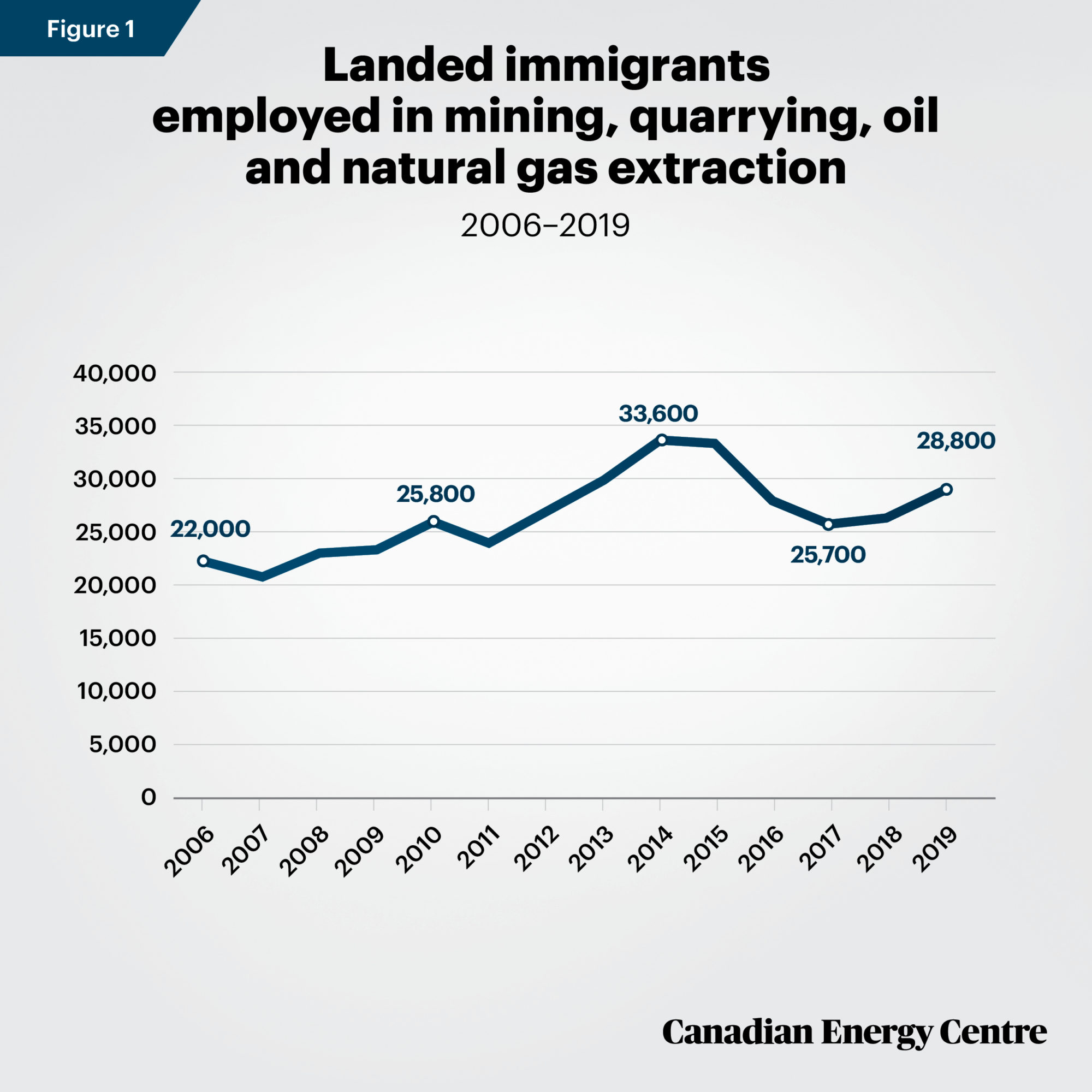
Source: Derived from Statistics Canada, Labour Force Survey, Custom Tabulation.
Figure 2: Average weekly wages by industry for landed immigrants
Landed immigrants employed in the mining, quarrying and oil and natural gas extraction sector are paid higher than other goods-producing industries, and higher than the average for all industries. In 2019, the average weekly wage was $1,041 for landed immigrants employed in agriculture, forestry, fishing and hunting; $1,184 for landed immigrants in the manufacturing sector; $1,407 in the construction sector; $1,855 in the utilities sector; and $2,032 in the mining, quarrying and oil and natural gas extraction sector. That allindustry average for landed immigrants was $1,186.
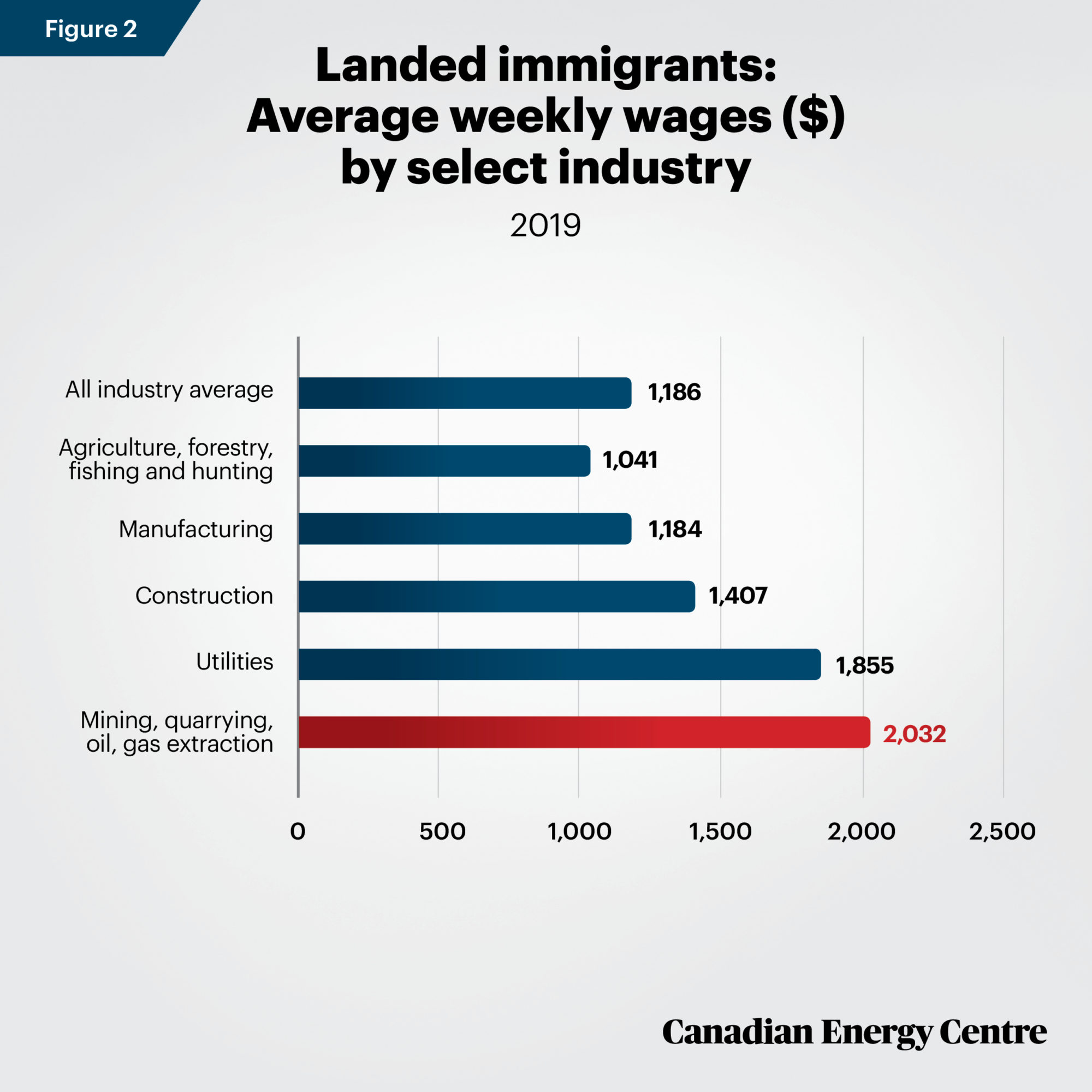
Source: Derived from Statistics Canada, Labour Force Survey, Custom Tabulation.
Figure 3: Immigrant wages in the broad resource sector 71% higher than all-industry average
Expressed as percentages, in 2019 immigrants employed in agriculture, forestry and fishing earned 14 per cent less than the all-industry average and those in manufacturing earned virtually same as the average, while those in construction earned 19 per cent more than the all-industries average, immigrants in utilities earned 57 per cent more, and those mining, quarrying, oil and gas earned 71 per cent more than the all-industries average.
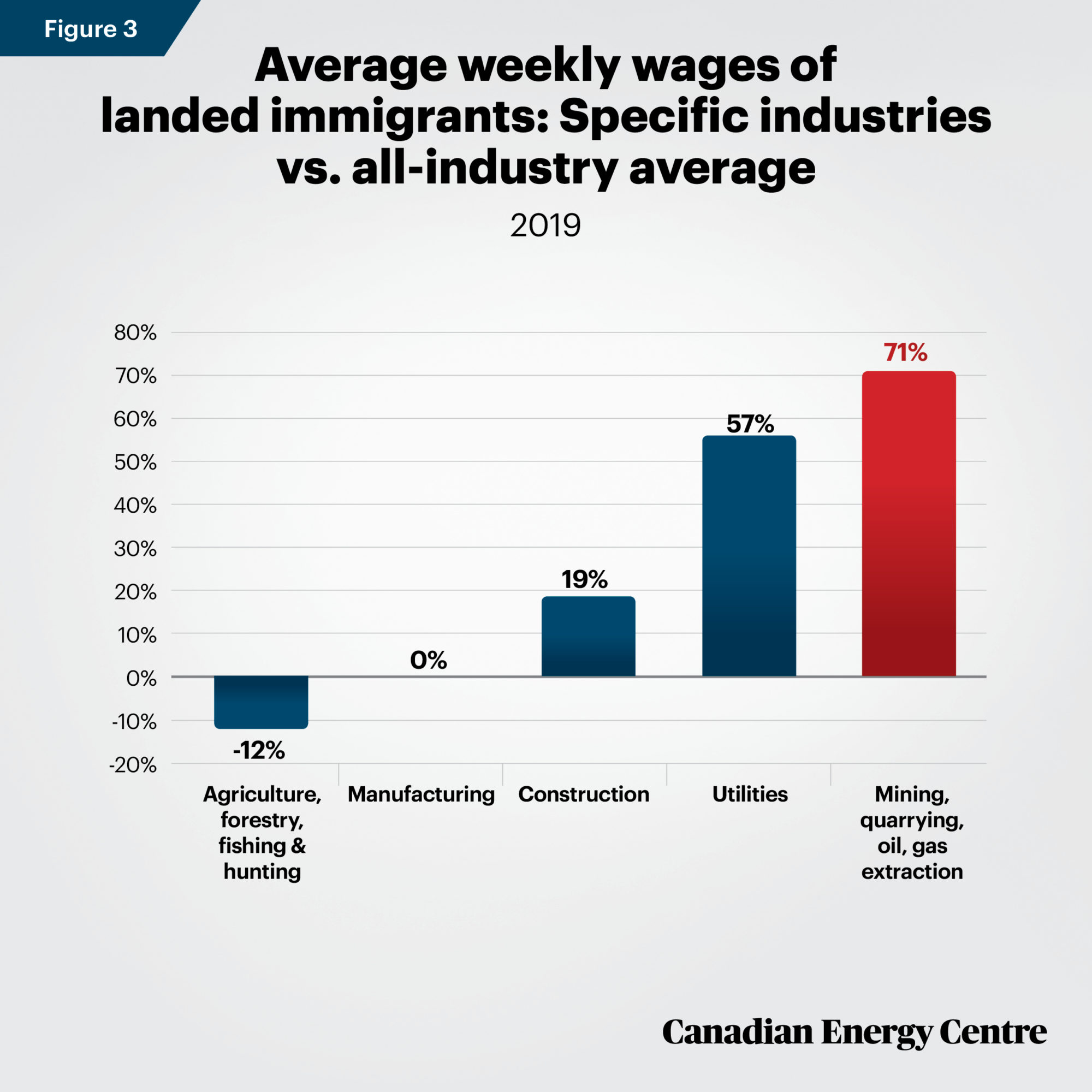
Source: Derived from Statistics Canada, Labour Force Survey, Custom Tabulation.
Figures 4 and 5: Highest immigrant wage increases in resource sector
Between 2006 and 2019, average weekly wages for landed immigrants employed in mining, quarrying and oil and natural gas extraction sector grew from $1,395 to $2,032, an increase of nearly 46 per cent (Figure 4). This compares to an 18 per cent increase for agriculture, forestry, fishing and hunting; a 21 per cent increase for utilities; a 42 per cent increase for construction; and a 22 per cent increase for manufacturing.
The all-industry average weekly wage increased by 28 per cent in 2019 relative to 2006. Expressed in dollar terms (Figure 5), the highest increase in weekly wages between 2006 and 2019 was $637 for mining, quarrying and oil and natural gas extraction compared to an all-industry average increase of $260.
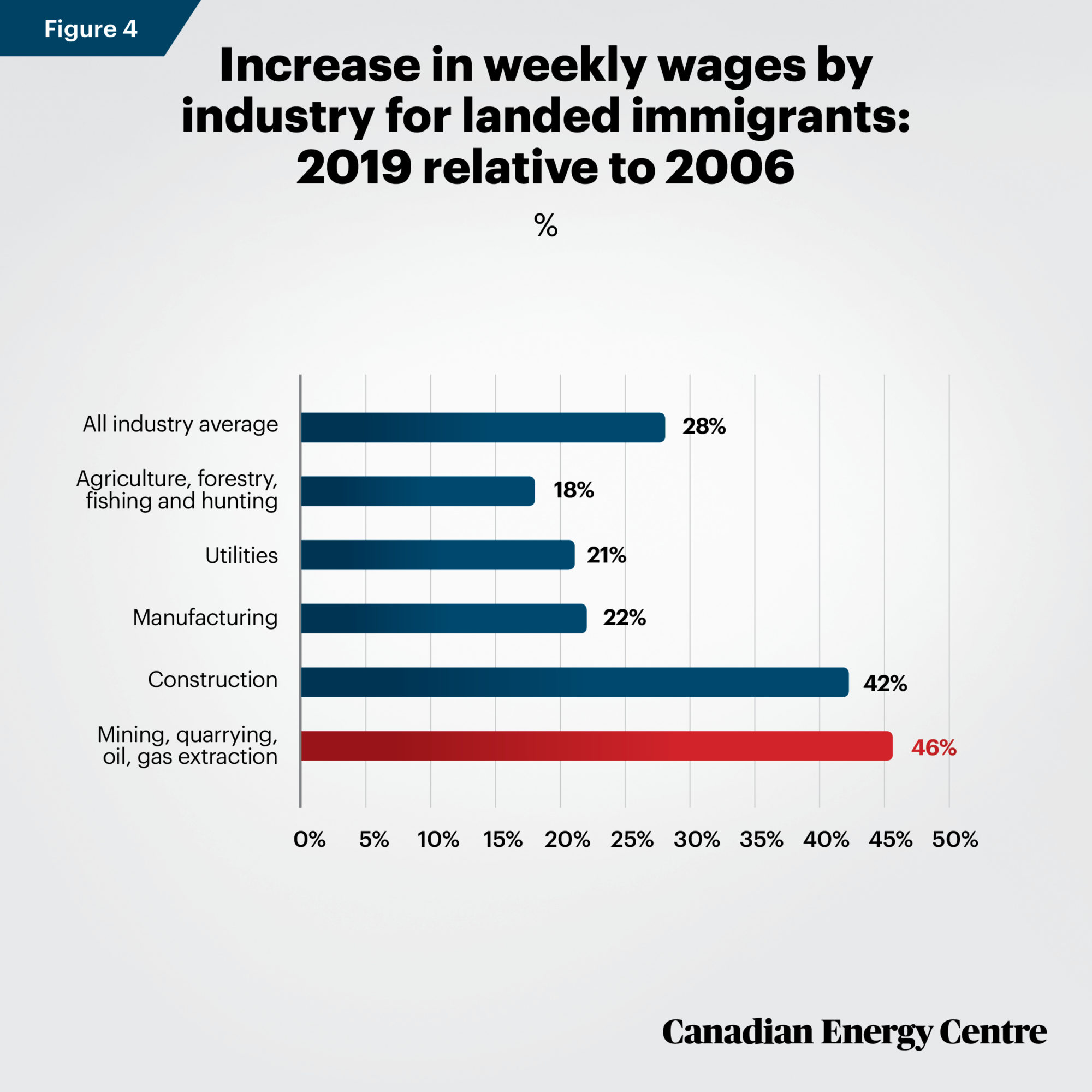
Source: Derived from Statistics Canada, Labour Force Survey, Custom Tabulation.
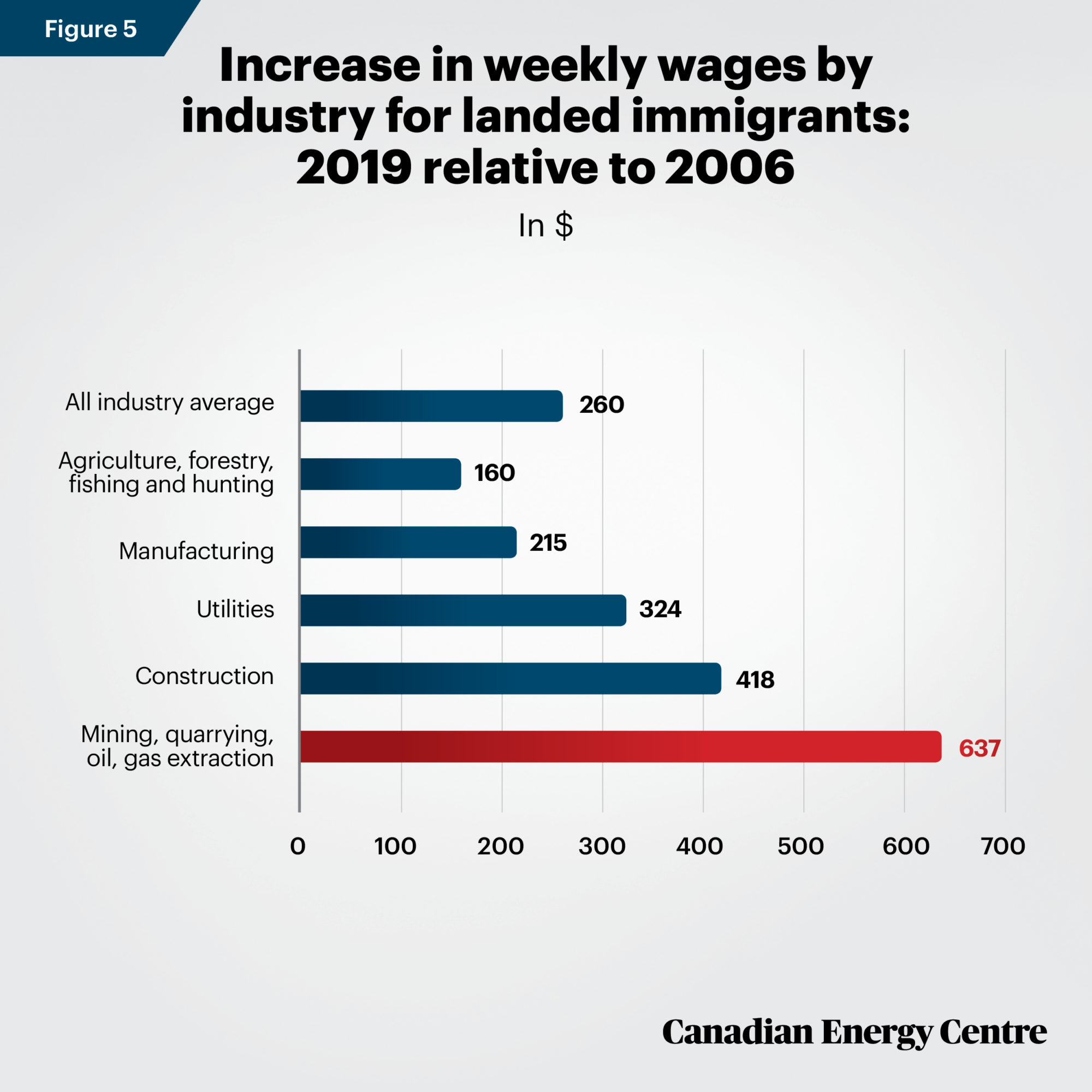
Source: Derived from Statistics Canada, Labour Force Survey, Custom Tabulation.
Notes
Terms and definitions used in this report related to employment and incomes can be accessed through Statistics Canada. This CEC Fact Sheet was compiled by Ven Venkatachalam, Lennie Kaplan, and Mark Milke, at the Canadian Energy Centre: www.canadianenergycentre.ca. The authors and the Canadian Energy Centre would like to thank and acknowledge the assistance of an anonymous reviewer in reviewing the data and research for this Fact Sheet. Image credits: “Petroleum Workers Positioning a Drill” by Keith Wood.
Sources (Links live as of May 20, 2020)
Statistics Canada (2017). The Daily, September 13. <https://bit.ly/357Lr4z>; Statistics Canada Table 14-10-0083-01; <https://bit.ly/3eQmwak>; Statistics Canada Table 17-10-0005-01. <https://bit.ly/3eOd1Z9>. Statistics Canada Table: 17-10-0014-01 <https://bit.ly/3510OMj>; Statistics Canada. Table 43-10-0021-01 <https://bit.ly/2zswcr9>; Statistics Canada Table: 17-10-0021-01 <https://bit.ly/35eKPKK>; Statistics Canada, Custom tabulation, Labour Force Survey, 0320_03 Table1.ivt.
About the Canadian Energy Centre (CEC)
The Canadian Energy Centre (CEC) is an independent provincial corporation that is primarily supported by the Government of Alberta’s industry-funded Technology, Innovation and Emissions Reduction (TIER) fund. The CEC’s mandate is to promote Canada as the supplier of choice for the world’s growing demand for responsibly produced energy. At its core, the CEC will also create a new, pragmatic, fact-based narrative about Canadian energy.
Creative Commons Copyright
Research and data from the Canadian Energy Centre (CEC) is available for public usage under creative commons copyright terms with attribution to the CEC. Attribution and specific restrictions on usage including non-commercial use only and no changes to material should follow guidelines enunciated by Creative Commons here: Attribution-NonCommercial-NoDerivs CC BY-NC-ND.
Share This:





 CDN NEWS |
CDN NEWS |  US NEWS
US NEWS 
































